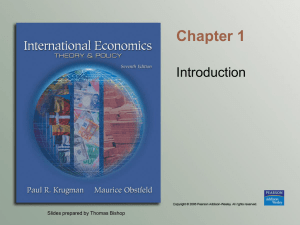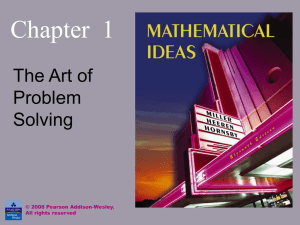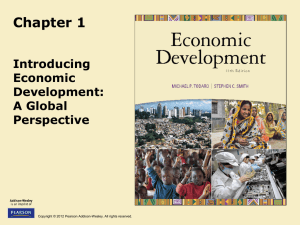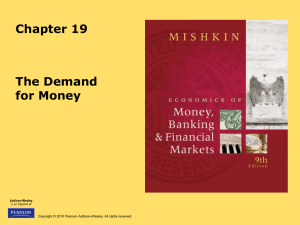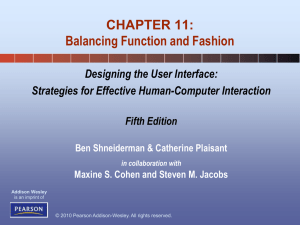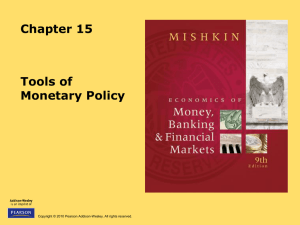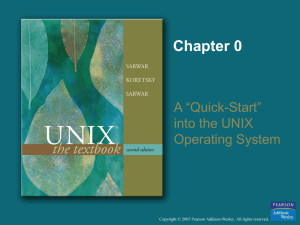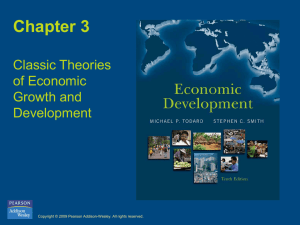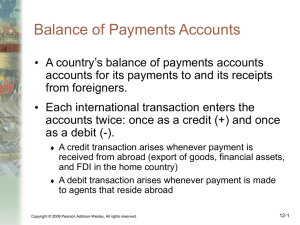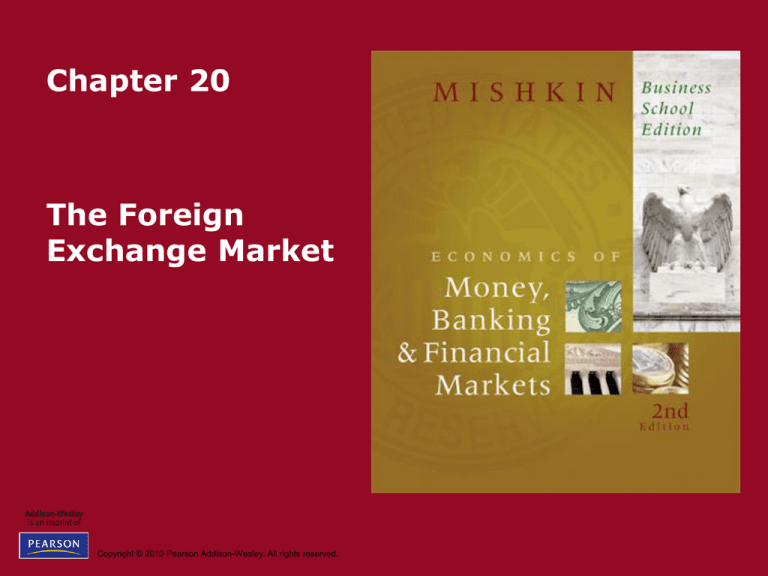
Chapter 20
The Foreign
Exchange Market
Copyright © 2010 Pearson Addison-Wesley. All rights reserved.
Foreign Exchange I
• Exchange rate: price of one currency in terms of
another
• Foreign exchange market: the financial market
where exchange rates are determined
• Spot transaction: immediate (two-day) exchange of
bank deposits
– Spot exchange rate
• Forward transaction: the exchange of bank deposits
at some specified future date
– Forward exchange rate
Copyright © 2010 Pearson Addison-Wesley. All rights reserved.
20-2
Foreign Exchange II
• Appreciation: a currency rises in value
relative to another currency
• Depreciation: a currency falls in value
relative to another currency
• When a country’s currency appreciates, the
country’s goods abroad become more
expensive and foreign goods in that country
become less expensive and vice versa
• Over-the-counter market mainly banks
Copyright © 2010 Pearson Addison-Wesley. All rights reserved.
20-3
FIGURE 1 Exchange Rates, 1990–
2008
Source: Federal Reserve: www.federalreserve.gov/releases/h10/hist.
Copyright © 2010 Pearson Addison-Wesley. All rights reserved.
20-4
Exchange Rates in the Long
Run
• Law of one price
• Theory of Purchasing Power Parity
assumptions:
– All goods are identical in both countries
– Trade barriers and transportation costs are low
– Many goods and services are not traded across
borders
Copyright © 2010 Pearson Addison-Wesley. All rights reserved.
20-5
Factors that Affect Exchange
Rates in the Long Run
• Relative price levels
• Trade barriers
• Preferences for domestic versus foreign
goods
• Productivity
Copyright © 2010 Pearson Addison-Wesley. All rights reserved.
20-6
FIGURE 2 Purchasing Power Parity, United
States/United Kingdom, 1973–2008 (Index:
March 1973 = 100.)
Source: ftp.bls.gov/pub/special/requests/cpi/cpiai.txt.
Copyright © 2010 Pearson Addison-Wesley. All rights reserved.
20-7
Summary Table 1 Factors That Affect
Exchange Rates in the Long Run
Copyright © 2010 Pearson Addison-Wesley. All rights reserved.
20-8
Exchange Rates in the Short Run: A
Supply and Demand Analysis
• An exchange rate is the price of domestic
assets in terms of foreign assets
• Supply curve for domestic assets
– Assume amount of domestic assets is fixed
(supply curve is vertical)
• Demand curve for domestic assets
– Most important determinant is the relative
expected return of domestic assets
– At lower current values of the dollar (everything
else equal), the quantity demanded of dollar
assets is higher
Copyright © 2010 Pearson Addison-Wesley. All rights reserved.
20-9
FIGURE 3 Equilibrium in the
Foreign Exchange Market
Copyright © 2010 Pearson Addison-Wesley. All rights reserved.
20-10
Explaining Changes in
Exchange Rates
• Shifts in the demand for domestic assets
– Domestic interest rate
– Foreign interest rate
– Expected future exchange rate
Copyright © 2010 Pearson Addison-Wesley. All rights reserved.
20-11
FIGURE 4 Response to an Increase
in the Domestic Interest Rate, iD
Copyright © 2010 Pearson Addison-Wesley. All rights reserved.
20-12
FIGURE 5 Response to an Increase
in the Foreign Interest Rate, iF
Copyright © 2010 Pearson Addison-Wesley. All rights reserved.
20-13
FIGURE 6 Response to an Increase in
the Expected Future ExchangeRate, Eet+1
Copyright © 2010 Pearson Addison-Wesley. All rights reserved.
20-14
Summary Table 2 Factors That Shift the
Demand Curve for Domestic Assets and Affect
the Exchange Rate
Copyright © 2010 Pearson Addison-Wesley. All rights reserved.
20-15
FIGURE 7 Effect of a Rise in the Domestic
Interest Rate as a Result of an Increase in
Expected Inflation
Copyright © 2010 Pearson Addison-Wesley. All rights reserved.
20-16
Application: Changes in the
Equilibrium Exchange Rate
• Changes in Interest Rates
– When domestic real interest rates raise, the
domestic currency appreciates.
– When domestic interest rates rise due to an
expected increase in inflation, the domestic
currency depreciates.
• Changes in the Money Supply
– A higher domestic money supply causes the
domestic currency to depreciate.
Copyright © 2010 Pearson Addison-Wesley. All rights reserved.
20-17
Application: Changes in the
Equilibrium Exchange Rate
• Exchange Rate Overshooting
• Monetary Neutrality
– In the long run, a one-time percentage rise in
the money supply is matched by the same onetime percentage rise in the price level
• The exchange rate falls by more in the short
run than in the long run
– Helps to explain why exchange rates exhibit so
much volatility
Copyright © 2010 Pearson Addison-Wesley. All rights reserved.
20-18
FIGURE 8 Effect of a Rise in the
Money Supply
Copyright © 2010 Pearson Addison-Wesley. All rights reserved.
20-19
Application: The Dollar and
Interest Rates
• While there is a strong correspondence
between real interest rates and the
exchange rate, the relationship between
nominal interest rates and exchange rate
movements is not nearly as pronounced
Copyright © 2010 Pearson Addison-Wesley. All rights reserved.
20-20
FIGURE 9 Value of the Dollar and
Interest Rates, 1973–2008
Sources: Federal Reserve: www.federalreserve.gov/releases/h10/summary/indexn_m.txt; real interest rate from Figure 1 in Chapter 4.
Copyright © 2010 Pearson Addison-Wesley. All rights reserved.
20-21
Application: The Subprime
Crisis and the Dollar
• During 2007 interest rates fell in the United
States and remained unchanged in Europe.
• The dollar depreciated
• Starting in the summer of 2008 interest
rated fell in Europe.
• Increased demand for U.S. Treasuries “flight
to quality”
• The dollar appreciated
Copyright © 2010 Pearson Addison-Wesley. All rights reserved.
20-22




